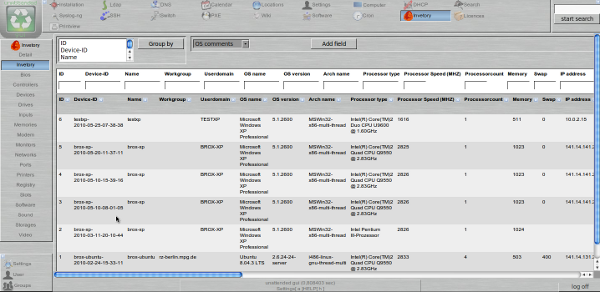 In the 3 former articles of this series we have saw OCSInventory, Fusion Inventory and GLPI 3 software that can create an asset inventory with your computers hardware and software.
In the 3 former articles of this series we have saw OCSInventory, Fusion Inventory and GLPI 3 software that can create an asset inventory with your computers hardware and software.
Today we’ll take a look at another software: Uranos (Unattended Resolution in A Nutshell – OS).
Unattended Resolution in A Nutshell – OS is an open source software that will let you perform Asset Management, Monitoring, Software Distribution,Unattended tasks. It’s free for both personal and commercial use and released under GPL license.
The project it’s active and the last version (at the moment of the writing of this post) it’s the 1.1913 released on 22 December 2011
Uranos is not just an asset management software like the others, it’s a modular framework with many module that can do many different tasks.
The software run as web application, so it needs an HTTP Web server that can run php code, an Apache Web Server with Mod_php will work perfectly.
Design
The design of uranos is build to have an easy application framework, you can choose which module use, all use the basic “services”:
- Authentification
- Database
- Securtity
- Search
- Calendar
Uranos is built to give you an environment which includes this main functionality:
- Permission management
- Authentification to database, LDAP (also M$ Active Directory), IMAP, Radius
- User[+Group]backend: database or LDAP
- Different security checks (e.g. Prevent Session Hijacking, check POST,GET and FILE variables,….)
- Templating for easy customize the views
- Installing the webapplication
So Uranos can be used to do a lot of different things, install software, install a machine from scratch, configure and use DNS, DHCP and LDAP from the web; but it’s time to return on our topic: Asset Managment
Asset Managment
Uranos can use FusionInventory as agent to gather information using the module Inventory, these information will be displayed in the section Computer.
The computer module is used to manage the computer inventory and configuration for software, partitioning and os.

Also the Computer module it’s the main entry point for the connectors.
The main idea behind the connectors is that you can bind easy functionality to your computers. It is a precondition that you install the module computer to use the connectors.
The internal connectors are:
- Checklist
- Comments
- DHCP Ldap
- DNS Ldap
- Inventory (fusioninventory)
- Status
For the asset there is also an OCSInventory-ng connector, that will search your OCS database for the computername and display the results. An alternative to the Fusion inventory Connector to show asset information.
If you are curios of what Uranos look like you can check their demo on sourceforge , some of the main modules are installed and so you can do some tests.
Conclusions
Uranos does a lot of things, and if you are searching for a central framework that can also install software and servers perhaps you can stop your research; Uranos seem a product that can do a lot of different things from a central console.
But i’ve some doubt if you just need an asset management software, it rely on FusionInventory or OCS so you’ll have to study and install these software too, and install and maintain Uranos just for managing the assets seem an overkill to me.
Popular Posts:
- None Found

Commas are pauses. Commas, do not just go immediately after the subject as I’ve intentionally done here. Commas are pauses, and not stops; use a semi-colon for that. If you find, you are putting, commas randomly, in, your, sentence, then you’re doing it wrong. Consider reading the sentence aloud a few times, paying attention to what you are writing as well as what you want to write, until you know that you have written what you want. If we can’t read what you’ve written, then we don’t know what you’re saying; this is often considered a hindrance to you making your point effectively.